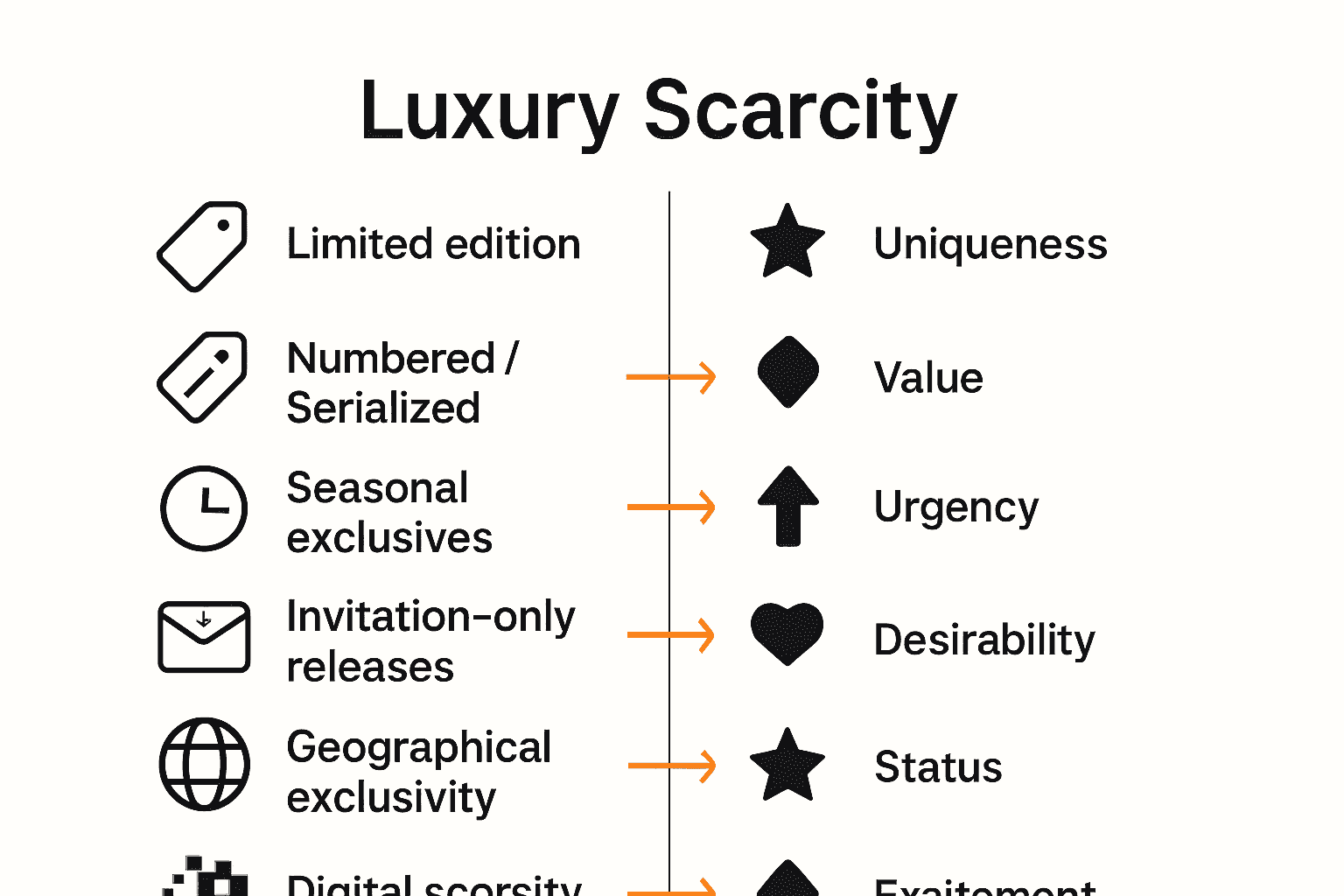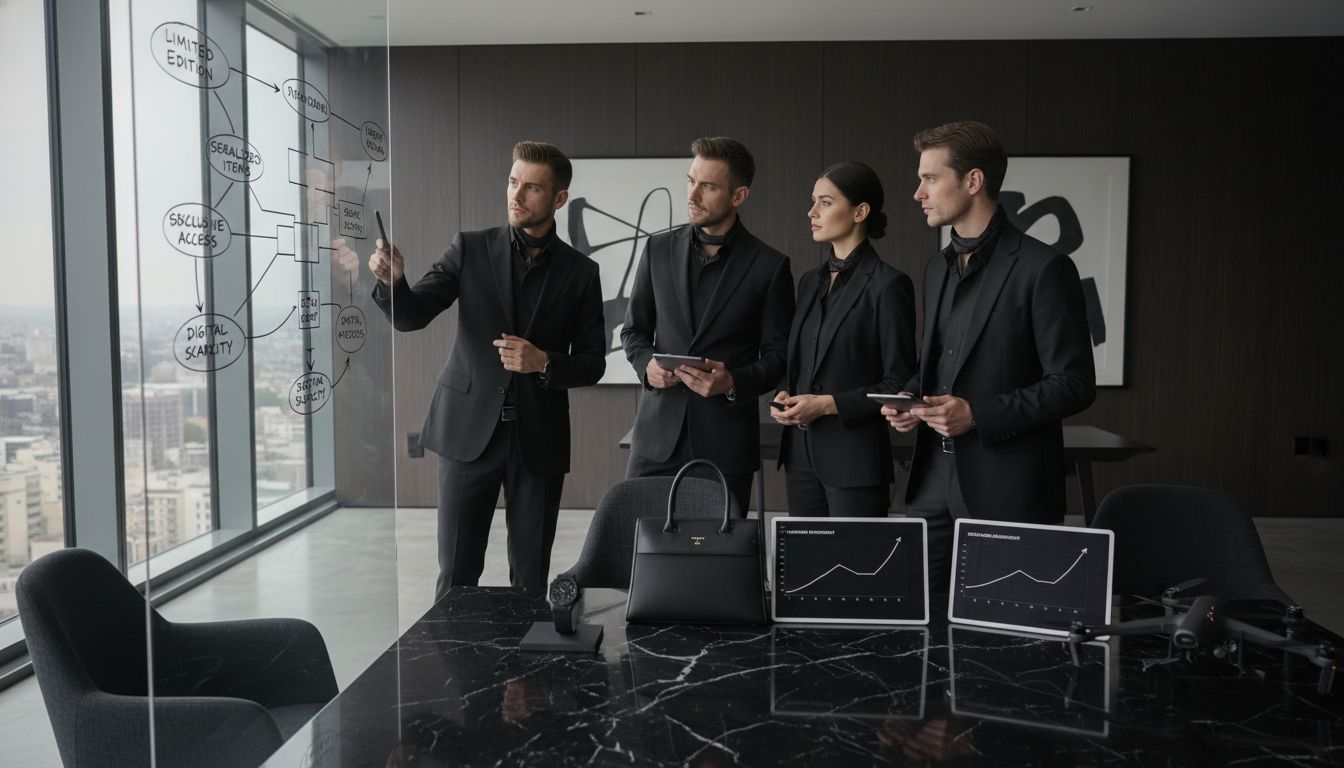Did you know that products marketed as exclusive see a 40 percent increase in consumer desire compared to regular items? Scarcity has become a powerful force for luxury brands, turning limited access into a symbol of status and value. As competition intensifies, understanding how these brands create longing and anticipation through rare offerings reveals the art behind transforming everyday products into coveted cultural icons.
Table of Contents
- Defining Scarcity In Luxury Marketing
- Types Of Scarcity Used By Luxury Brands
- Psychological Impact On Luxury Consumers
- Real-World Applications In Luxury Sectors
- Risks, Missteps, And Industry Best Practices
Key Takeaways
| Point | Details |
|---|---|
| Psychological Leverage of Scarcity | Luxury brands use scarcity to enhance perceived value and exclusivity, creating emotional connections with consumers. |
| Diverse Scarcity Techniques | Strategies such as limited editions and exclusive releases are employed to transform products into cultural artifacts. |
| Consumer Behavior Insights | Scarcity increases desirability and triggers purchasing motivations through fear of missing out and social validation. |
| Risks of Mismanagement | Overuse of scarcity tactics can lead to consumer skepticism and potential threats to brand credibility; maintaining transparency is essential. |
Defining Scarcity in Luxury Marketing
Scarcity is a sophisticated psychological strategy that luxury brands meticulously leverage to transform product availability from a simple economic transaction into an emotional experience. According to research from drpress, scarcity in luxury marketing refers to the deliberate limitation of product availability specifically designed to enhance perceived value and exclusivity.
At its core, scarcity operates by creating a profound sense of urgency and desire that transcends traditional consumer purchasing behaviors. As insights from openworks reveal, luxury brands strategically employ exclusivity cues that often directly contradict conventional economic theories of supply and demand. This approach transforms product limitations from potential obstacles into powerful marketing instruments.
The mechanics of scarcity in luxury marketing involve several nuanced psychological triggers:
- Limited Production Runs: Creating products with strictly controlled quantities
- Exclusive Access: Offering products only to select clientele
- Time-Sensitive Availability: Launching collections for brief, defined periods
- Personalized Allocation: Presenting items as rare, custom experiences
Understanding scarcity requires recognizing it as more than a mere marketing tactic. It is a sophisticated narrative that repositions products from commodities to coveted cultural artifacts, where rarity itself becomes a form of value. Luxury brands do not simply sell items they curate experiences of exceptional desirability.
By strategically restricting availability, brands transform potential consumer frustration into an aspirational journey. The result? A powerful emotional connection that elevates products from mere objects to symbols of status, exclusivity, and personal achievement.
Types of Scarcity Used by Luxury Brands
Luxury brands have developed a sophisticated arsenal of scarcity strategies that go far beyond simple product limitation. Research from hrcak reveals these brands utilize multiple approaches to enhance desirability, particularly among younger consumer segments like millennials.
The most prevalent types of scarcity in luxury marketing include:
Here’s a comparison of major scarcity techniques used by luxury brands:
| Scarcity Type | Example Brands | Key Consumer Impact |
|---|---|---|
| Limited Edition | Supreme Rolex |
Urgency to purchase |
| Numbered/Serialized | Ferrari Hublot |
Perceived uniqueness |
| Seasonal Exclusives | Dior Gucci |
Anticipation for launches |
| Invitation-Only Releases | Birkin by Hermès Patek Philippe |
Heightened sense of privilege |
| Geographical Exclusivity | Louis Vuitton Chanel |
Regional desirability |
| Digital Scarcity | Nike SNKRS Adidas Confirmed |
Virtual engagement & hype |
- Limited Edition Collections: Producing extremely restricted product runs
- Numbered/Serialized Items: Creating uniquely identifiable pieces
- Seasonal Exclusives: Launching time-sensitive product lines
- Invitation-Only Releases: Restricting access to select clientele
- Geographical Exclusivity: Offering products only in specific markets
According to insights from curtin, retail presentation plays a critical role in perceived scarcity. How products are displayed can significantly influence consumer perceptions, with limited availability inherently signaling higher quality and exclusivity.
Advanced scarcity techniques extend beyond physical product constraints. Luxury brands now employ digital scarcity through controlled online releases, virtual waiting lists, and carefully managed digital storytelling that transforms product acquisition into an exclusive experience. These strategies convert potential consumer frustration into a sense of anticipation and privilege, making the pursuit of the product as compelling as the product itself.
By meticulously controlling product availability across multiple dimensions, luxury brands transform scarcity from a simple marketing technique into a powerful emotional narrative.

 Each restricted release becomes more than a transaction – it’s an invitation to participate in an elite, carefully curated brand experience.
Each restricted release becomes more than a transaction – it’s an invitation to participate in an elite, carefully curated brand experience.
Psychological Impact on Luxury Consumers
The psychology of scarcity in luxury marketing is a profound exploration of human desire and perceived value. According to Wikipedia), scarcity fundamentally alters consumer behavior, compelling individuals to place significantly higher value on items perceived as rare or limited.
Key psychological mechanisms triggered by scarcity include:
- Heightened Perceived Value: Rare items instantly become more desirable
- Fear of Missing Out (FOMO): Potential loss creates intense purchasing motivation
- Social Validation: Exclusive products signal unique social status
- Emotional Investment: The pursuit becomes as compelling as ownership
Interestingly, Wikipedia (en anglais) reveals that luxury consumers engage in conspicuous consumption driven by products’ perceived scarcity and social signaling potential. This psychological mechanism transforms purchasing from a transactional experience into a complex emotional journey of self-representation and social positioning.
The emotional architecture of scarcity operates on multiple psychological levels. Luxury brands don’t just sell products they craft narratives of exclusivity that tap into deep-seated human desires for uniqueness, recognition, and belonging. By carefully controlling product availability, these brands create a powerful emotional ecosystem where limitation becomes a form of aspiration.
Ultimately, scarcity in luxury marketing is a sophisticated psychological dance. It leverages fundamental human instincts of desirability, social hierarchy, and personal identity, transforming simple consumer choices into profound statements of individual worth and social belonging. Each restricted release becomes an invitation to participate in an exclusive narrative that extends far beyond the physical product itself.
Real-World Applications in Luxury Sectors
Scarcity marketing has become a sophisticated strategic approach across multiple luxury sectors, transforming product positioning and consumer engagement. According to insights from Medium, brands like Supreme and Nike have pioneered advanced scarcity techniques through strategic limited releases and exclusive drops, creating unprecedented market demand and vibrant secondary markets.
Different luxury sectors implement scarcity strategies uniquely:
- Fashion: Runway-exclusive collections with extremely limited quantities
- Automotive: Custom model configurations with restricted production numbers
- Spirits and Wine: Small-batch releases and vintage exclusives
- Hospitality: Exclusive membership programs with restricted access
- Technology: Limited edition collaborations and numbered product releases
Research from MTMI highlights how luxury brands like Krug champagne and Ferrari masterfully balance production limitations. These brands create what experts call ‘abundant rarity’ – a nuanced approach that maintains exclusivity while allowing controlled market growth.
The most successful scarcity applications go beyond mere production limits. They craft compelling narratives around each restricted release, transforming products into cultural artifacts. By carefully controlling availability, luxury brands convert potential consumer frustration into heightened anticipation, turning each product launch into a quasi-event that transcends traditional marketing.
Modern scarcity strategies represent a sophisticated psychological contract between brands and consumers. Each limited release becomes an invitation to participate in an exclusive experience, where the act of acquisition is as meaningful as the product itself. This approach doesn’t just sell items it sells aspirational membership in a carefully curated, elite consumer ecosystem.
Risks, Missteps, and Industry Best Practices
Scarcity marketing, while powerful, requires nuanced execution to avoid potential pitfalls. According to Wikipedia (en anglais), artificial scarcity poses significant risks, where brands might restrict availability despite having sufficient production capacity, potentially triggering consumer frustration and ethical concerns.
Key risks in scarcity marketing include:
- Consumer Skepticism: Overused scarcity tactics can appear manipulative
- Brand Credibility Erosion: Repeated false limitations damage trust
- Secondary Market Complications: Uncontrolled resale markets can undermine pricing strategies
- Potential Legal Challenges: Misleading production claims can attract regulatory scrutiny
- Customer Alienation: Excessive exclusivity might repel potential consumers
Research from Wikipedia (en anglais) highlights the scarcity development cycle, demonstrating how perceived product limitation can initially drive demand but may ultimately lead to diminished brand value if not carefully managed. Successful luxury brands must strike a delicate balance between creating genuine exclusivity and maintaining consumer accessibility.
Industry best practices demand transparency, authenticity, and strategic implementation. Brands must ground their scarcity strategies in genuine product excellence, creating limitations that feel organic rather than manufactured. This means developing truly unique offerings, maintaining high production quality, and communicating the genuine reasons behind product restrictions.
Ultimately, scarcity in luxury marketing is a sophisticated psychological strategy that requires profound understanding of consumer emotions. The most successful approaches transform limitation from a marketing tactic into a genuine narrative of craftsmanship, innovation, and exceptional value. When executed with integrity, scarcity becomes less about restriction and more about celebrating the extraordinary.
Harness Scarcity to Elevate Your Luxury Brand
Scarcity creates a powerful emotional connection with consumers by transforming product rarity into desire. If your luxury brand struggles to authentically build exclusivity or capture that coveted emotional engagement, the challenge lies in mastering scarcity as a strategic narrative — not just a sales tactic. You need marketing that taps deeply into psychological triggers like FOMO and social validation while maintaining authenticity and trust.

Discover how Corrado Manenti can help you integrate psychology-driven marketing and meticulous luxury consulting to craft scarcity strategies that resonate. Learn how to balance genuine exclusivity with innovative digital positioning to turn limited releases into aspirational experiences. Start elevating your brand’s presence today with expert insights at Marketing Fashion – Corrado Manenti and explore advanced digital strategies at Digital Positioning – Corrado Manenti. Ready to transform scarcity into your brand’s greatest asset Discover more at Corrado Manenti and take the first step toward market leadership.
Frequently Asked Questions
What is the significance of scarcity in luxury marketing?
Scarcity in luxury marketing enhances the perceived value and exclusivity of products by creating a sense of urgency and desire, transforming purchasing behavior into an emotional experience.
What are some common types of scarcity used by luxury brands?
Luxury brands use various types of scarcity techniques, including limited edition collections, numbered or serialized items, seasonal exclusives, invitation-only releases, geographical exclusivity, and digital scarcity to enhance product desirability.
How does scarcity affect consumer psychology?
Scarcity impacts consumer psychology by increasing perceived value, triggering the fear of missing out (FOMO), providing social validation through unique products, and fostering emotional investment in the purchase process.
What are the risks associated with scarcity marketing?
The risks include consumer skepticism towards overused tactics, potential erosion of brand credibility, complications with secondary markets, potential legal challenges, and the risk of alienating customers if exclusivity is too excessive.



